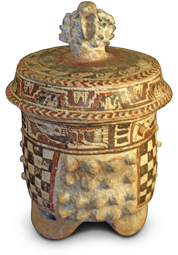Disentangling Iconography in Borderlands: Nonhuman Actors and Authority in Honduran Classic Polychromes
Desenredando la iconografía en las tierras fronterizas: actores no humanos y autoridad en las policromías clásicas hondureñas
In this paper I illustrate how semiotic analysis of art can be produced for a region for which we lack contemporaneous texts. The Ulúa Polychrome tradition of Honduras, which developed in the borderlands of Classic Maya society between ad 450 and 950, has been viewed as a variant of the Maya Lowland ceramic tradition. Instead, I show how key aspects of the iconography of these pots at the moment of greatest entanglement of Ulúa people with their Maya neighbors can only be understood in relation to a distinct indigenous Honduran history. Despite superficial similarities between these ceramic traditions, the depiction of nonhuman actors and the framing of human authority are part of a specific Honduran visual culture and aesthetic. The case study demonstrates how archaeological materials can provide a context through their visual and material indexicality, which illuminates features that might be missed by using more general guidance from texts covering neighboring and later societies.
Keywords: Honduras, Ulúa, borderland, authority, vessels, iconography.
INTRODUCTION
How can we interpret works of art from societies that left no texts to assist our understanding? Scholars seeking to understand those produced between ad 500 to 1000 in Honduras face this challenge (fig. 1). Through analy-zing thousands of artworks from the region (Joyce 2007, 2017; Hendon et al. 2014), I developed an approach that builds on insights from semiotics. Semiotics shows how meanings that are constantly generated can be approximated through contextual frameworks provided by other art works and archaeological materials.
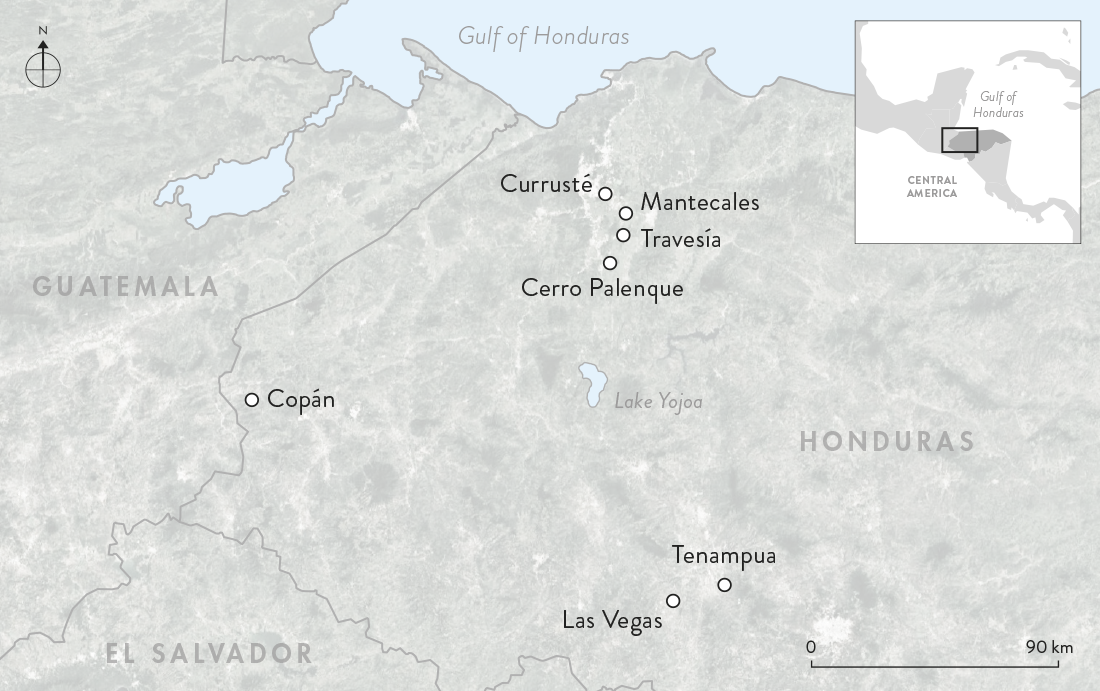
Figure 1. Map showing the discussed sites in the Ulúa region (illustration by the author). Figura 1. Mapa de los sitios discutidos de la región de Ulúa (ilustración de la autora).
Consider a cylindrical fired clay vessel from the Ulúa valley (fig. 2). A rectangular panel within the pictorial space wraps around the vessel, defined by red bounding lines on the right of, above, and below motifs. Two vertical compositions occupy this panel. On the right is an anthropomorphic figure facing left, one foot in front of the other, arms crossed in front of the profile chest. The body is painted black. The feet are filled in a darker orange tone. The profile head presents an eye, nose, and mouth, with a round disk where we would expect to see an ear.
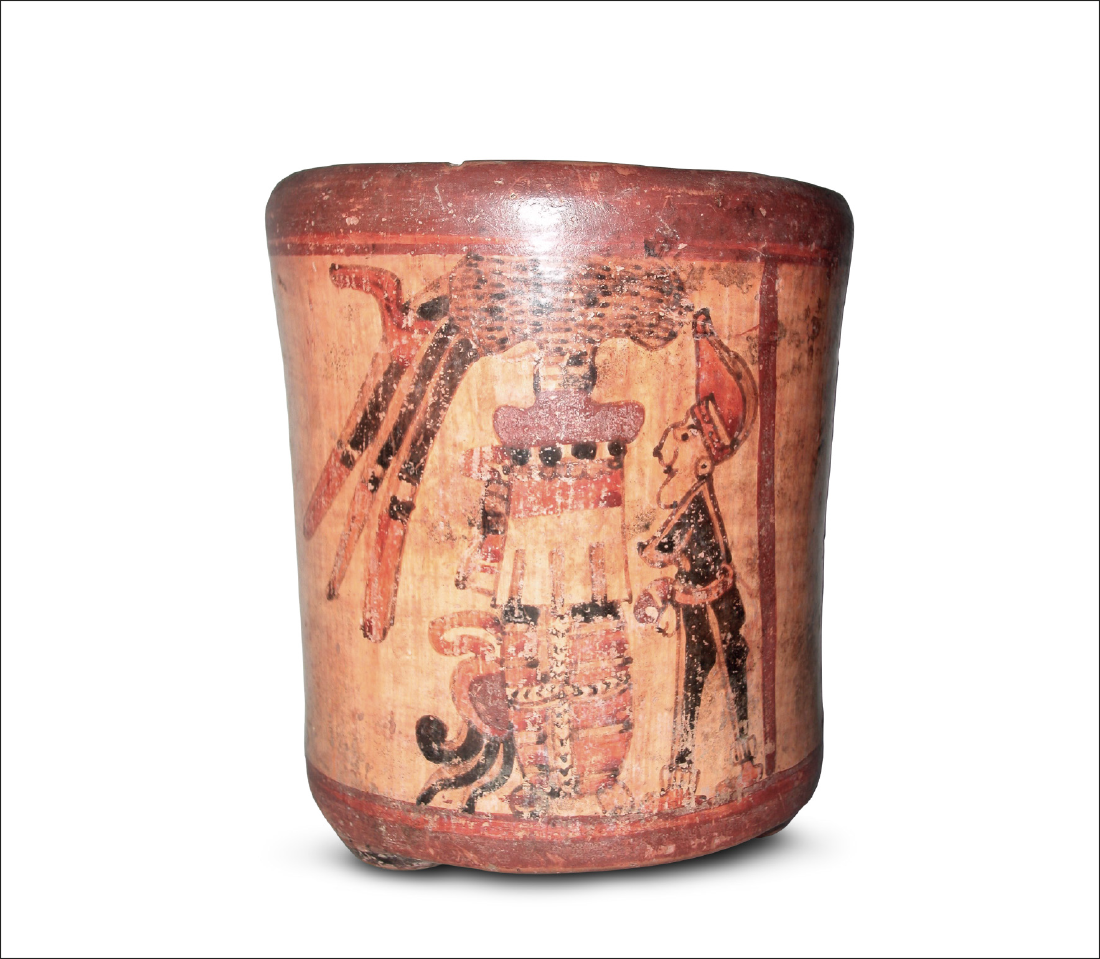
Figure 2. Ulúa Polychrome vase, Molinero subclass (ca. ad 700-750), Yojoa, Museo de Antropología e Historia (ab 11), San Pedro Sula, Honduras (photo by Russell N. Sheptak). Figura 2. Vaso Ulúa Policromo, subclase Molinero (ca. 700-750 dc), Yojoa, Museo de Antropología e Historia (ab 11), San Pedro Sula, Honduras (fotografía de Russell N. Sheptak).
The second vertical element extends from the top bounding line to the bottom, and wraps around the vessel on the left. It is not immediately recognizable in the way the anthropomorphic figure was. I identify this assemblage as a stack composed of a bird with a long feathered tail, standing on a pedestal wrapped in cut paper, sitting above a barrel-shaped vessel tied with ropes, ornamented with feathers, and supported on three feet. How can I read this image this way?
One basis for my ability to interpret these vertical assemblages is methods of visual analysis that rest on a long tradition of iconographic interpretation (Panofsky 1939, 1955). Developed initially for application to European materials, the success of the iconographic method depended on the existence of contextual material in the form of contemporary documents. Employed for the pre-Columbian Americas, iconographic methods have had to draw on alternative forms of contextualization: information from ethnographic observations of descendant peoples and historical accounts written in European alphabets by outside observers. This led George Kubler (1967:11-12; 1970: 143-144) to urge caution, based on the potential effects of the “principle of disjunction”, magnified by the changes introduced by Christianization and integration of European cultural concepts in indigenous cultures. Studies of Classic Maya period art works can draw on contemporary texts, written using an indigenous writing system, which have been translated from the original. The same is not true for the Ulúa region of Honduras.
The makers of Ulúa Polychromes were not speakers of a maya language, and never themselves used the maya writing system to construct texts. Social relations in the Ulúa Polychrome area were also different from those of hierarchical Maya polities. Ulúa Polychrome pots were used by a wide spectrum of people, unlike Classic Maya polychrome pottery, restricted to a small segment of nobles and rulers (Reents-Budet 1994). Re-cognizing these distinctions, I employ an alternative to the classic iconographic method, rooted in semiotics, in interpreting Ulúa Polychrome pottery. While not ignoring relationships with the contemporary Classic Maya, this grounds the analysis in contexts drawn from Ulúa social worlds known through archaeological research.
I begin with a brief summary of the cultural and historical context of the main media of Ulúa visual culture.(1) I review a critique of iconographic method by art historian Whitney Davis (2004) that helps clarify the challenge in using it for Ulúa materials. I present the semiotic framework I use, where meaning is understood as emerging through the interaction of viewers with visual media: viewers with knowledge of the histories in which visual media were entangled –interactions and histories that, I argue, we can recognize through archaeological contextualization. I explore in detail two examples of how this approach helps us understand features of Ulúa Polychrome vessels as a specifically Honduran Lenca visuality.(2)
THE ULÚA REGION
Western Honduras is where the distribution of Mesoamerican languages gives way to the northernmost South American-related language family, Lenca (Costenla 1991). The distribution of Honduran Lenca languages coincides with the distribution of Ulúa Polychrome pottery, extending from the Caribbean coastal Ulúa valley, through an upland district around Lake Yojoa, to the Comayagua valley (fig. 1). Similar painted pottery classified by archaeologists as Salua Polychrome is found in El Salvador, where the closely related Salvadoran Lenca language is spoken.
Honduran settlement patterns show less site hierarchy than among their Classic Maya period neighbors (Joyce 2023). Archaeological projects in multiple areas have identified a pattern of villages and small towns (up to 100-200 buildings), with one settlement in each region eventually growing larger (between 500 and 600 buildings), still substantially smaller than Classic Maya Copan in western Honduras. In the lower Ulúa valley, Cerro Palenque grew to over 500 buildings after ad 800, when disruption of the network of Classic Maya city states was underway (Joyce 1991; Hendon 2010). Tenampua, in the Comayagua valley, reached comparable size in the 9th century ad (Dixon 1989; Hendon et al. 2014).
Before the 10th century ad, many people in the lower Ulúa valley lived in rural farming communities distributed along waterways (Hendon et al. 2014; Joyce 2023). Larger towns grew around centers with ballcourts and other larger buildings. There is no evidence for concentration of population immediately adjacent to town centers. This settlement pattern has been described as heterarchical, based on the simultaneous existence of different structuring principles underlying social relations, manifest in distinct patterns followed by farmers locating their homesteads and by patron families constructing town centers (Lopiparo 2007; Joyce et al. 2009; Hendon et al. 2014; Joyce 2023).
In towns such as Travesía, the town center and ballcourt were adjacent to a house compound identified as the residence of a leading family, patron of the games at the ballcourt (Stone 1941; Hendon 2010; Hendon et al. 2014). Differences between these families and those in smaller settlements in the Ulúa region are much less marked than those between nobles and commoners in the Maya Lowlands. Families living in Ulúa town centers were consumers of some imported ceramic vessels, obsidian blades, and rare metal alloy objects (Joyce 1991, 2017; Luke 2010). They supported the production of luxury items requiring special skill (Luke & Tykot 2007; Lopiparo & Hendon 2009; Hendon 2010). Families like these likely sponsored some of the elaborate ceremonies in which Ulúa art works were deployed, whose traces archaeologists have recovered (Hendon et al. 2014). Yet none of the individuals in these households was accorded distinctive burial treatment. For most purposes, these households employed the same locally produced ceramics as other families. This included modeled, carved, and painted ceramic objects, available in every village, town, and farmstead, that formed Ulúa visual culture.
ULÚA VISUAL CULTURE
Fired clay is the primary medium of Ulúa visual culture. Using molds, fired clay was made into small figurative sculptures representing humans, animals (fig. 3), and animal-human hybrids, many in the form of musical instruments (Lopiparo 2006; Lopiparo & Hendon 2009; Hendon et al. 2014; Lopiparo & Joyce 2022). Based on the ubiquity of mold fragments, figurines were made in every community. Molds were not used for mass production, but rather to allow less skilled practitioners to produce correct imagery (Lopiparo 2006). The normal end for these objects was to be discarded after use in ceremonies in households or town centers (Lopiparo & Joyce 2022). In rare cases, figurines were buried as part of ceremonial practice, either alone or with other figurines and artifacts (Joyce 1991; Lopiparo 2006, 2007).
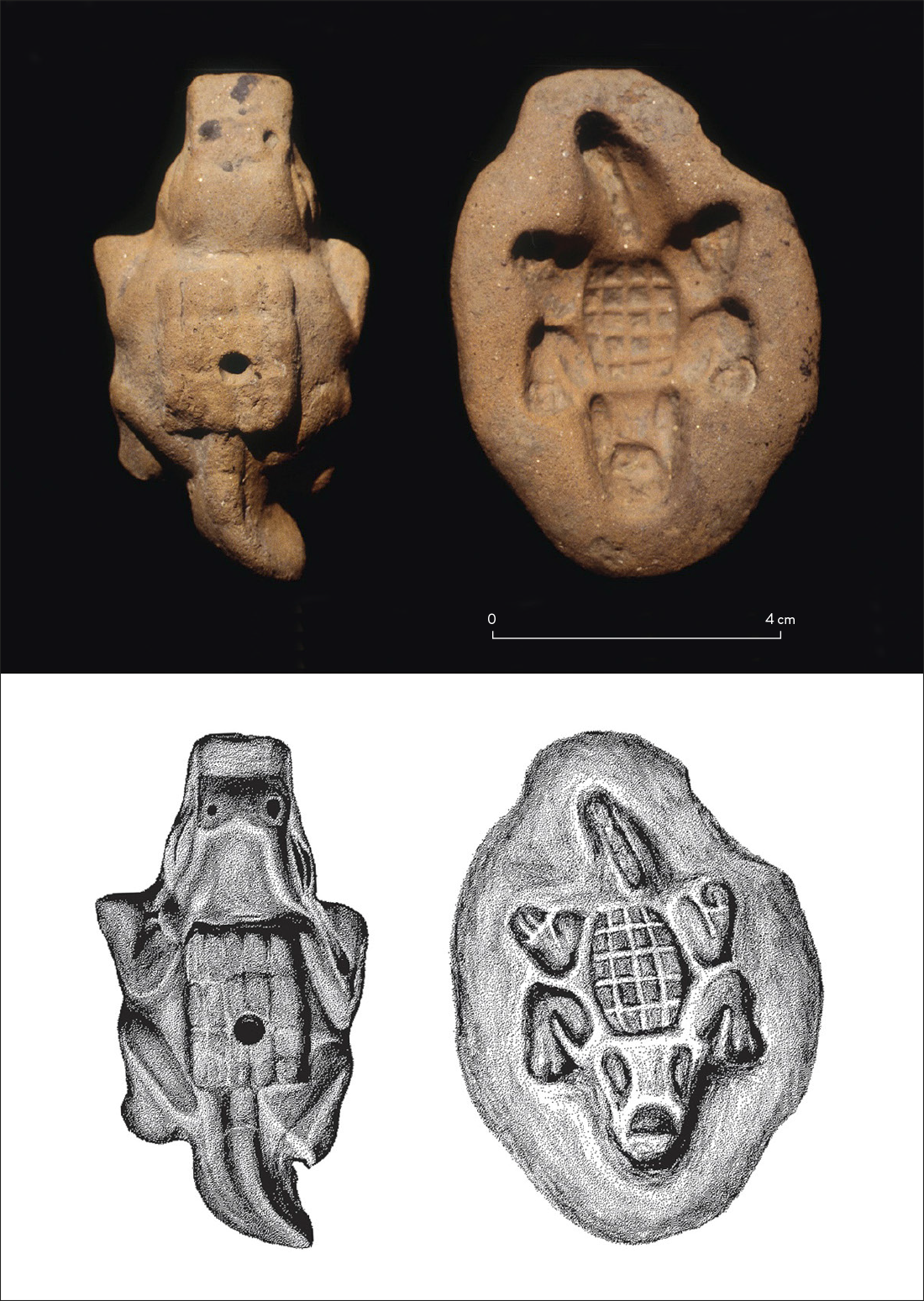
Figure 3. Figurine and mold, Campo Pineda, Honduras (photo and illustration by Jeanne Lopiparo). Figura 3. Figurilla y molde, Campo Pineda, Honduras (fotografía e ilustración de Jeanne Lopiparo).
Clay was also shaped into vessels appropriate for serving food and drink. The category Ulúa Polychrome denotes a group of vessels painted on orange-to-white slipped backgrounds, first made around ad 500 (Viel 1978; Joyce 2017). The iron-based pigments employed allowed production of shades ranging from bright red to light yellow, and from reddish-brown to a dark brown that appears black. These pigments fired to a glossy sheen. White pigments, present from the earliest to the latest periods, often appear matte, and can be more fragile although not fugitive. They likely were made from materials such as kaolin containing titanium dioxide, possibly the mineral anatase (Dinator & Morales 1990; Casanova 2016), or calcium, either calcium silicates or calcite (de la Fuente et al. 2021; Opriș et al. 2022). In addition to painted motifs, many Ulúa Polychromes have modeled vessel surfaces, and zones or bands that were unslipped and carved.
Ulúa Polychrome vessels, like Ulúa figurines, display repeated imagery, in this case produced by conventions of painting. Based on the distribution of firing facilities and other traces of production, not all settlements had artisans who made polychrome vases (Joyce et al. 2014; Joyce 2017). Yet the diversity of clay bodies shows Ulúa Polychromes were not products of a single center of production, either. At the beginning of their development, between ad 450 and 650, vessels from a wide area, from the Caribbean to El Salvador, carried virtually identical visual programs, even though their paste composition shows they were produced in multiple workshops. Beginning in the late 7th century ad, regional distinctions emerged in the lower Ulúa valley, the Lake Yojoa region, and the Comayagua valley. In the 8th and 9th century ad, two derived styles emerged in the Comayagua valley, at the Tenampua and Las Vegas sites, each employing whiter slip colors, the first emphasizing black and white compositions, the second orange, grey, and white (Joyce 2017, 2019). At the same time, settlements in the lower Ulúa valley stopped producing polychrome pottery in favor of unique local styles of unslipped thin-walled fine paste serving vessels (Joyce 1991, 2017).
A third component of Ulúa visual culture is large three-dimensional anthropomorphic and zoomorphic ceramic sculptures found in small numbers at multiple sites in the lower Ulúa valley (Hendon et al. 2014; Lopiparo & Joyce 2022). The technology to produce these may have constituted knowledge which was controlled by a small group of artisans (Lopiparo & Joyce 2022). Some represent animals, commonly felines, with details consistent with an overall Ulúa aesthetic of controlled repetition. In contrast, the anthropomorphic sculptures (fig. 4) have unique features, possibly representing specific members of a community. Excavations at two sites documented extensive contextual information about the use and disposal of these sculptures (Joyce & Pollard 2010; Hendon et al. 2014; Lopiparo & Joyce 2022). These studies show that these sculptures stood on pedestals which served as lids placed over vessels containing burning incense.

Figure 4. Ceramic sculpture of man holding a ceremonial axe, Naranjo Chino, Ulúa valley, National Museum of the American Indian (nmai), Smithsonian Institution (18/3214), Washington dc, United States (photo by nmai Photo Services). Figura 4. Escultura cerámica de un hombre sosteniendo un hacha ceremonial, Naranjo Chino, valle de Ulúa, National Museum of the American Indian (nmai), Smithsonian Institution (18/3214), Washington dc, Estados Unidos (fotografía de nmai Photo Services).
In parallel with these fired clay media, Ulúa artists created a small number of skeuomorphs of serving vessels (fig. 5). Only a few hundred of these Ulúa marble vases are known (Luke 2002). Christina Luke (2002, 2010) has outlined the development of the vessels in two stages. In the first stage, artists copied the shape and layout of Ulúa Polychrome vessels of the 7th century ad. In the second stage, emerging in the 8th century ad, the format and principal motifs of the initial version of Ulúa marble vases continued. New visual elements not seen on contemporary Ulúa pottery were developed. Christina Luke and Robert Tykot (2007) suggest that the uniformity of Ulúa marble vases was an outcome of their production in a limited number of workshops, perhaps only at the site where the largest number of these vessels has been identified, Travesía.
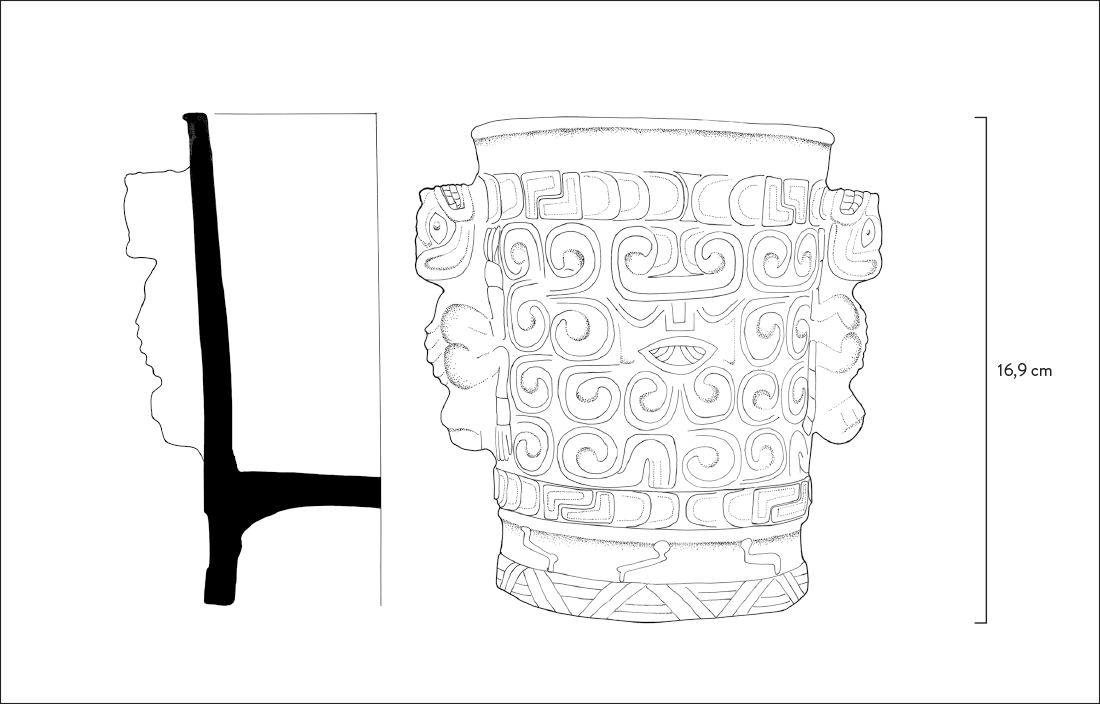
Figure 5. Ulúa Marble vase, Santana, Cortés, Honduras (illustration by Christina Luke). Figura 5. Vaso de mármol Ulúa, Santana, Cortés, Honduras (ilustración de Christina Luke).
A final medium, architectural stone sculpture, developed at the same time that innovative marble vase production was initiated at Travesía. Occupants of the principal household at that site covered the walls and floors of their residence with thick white stucco. In some places they added to their stone houses slabs of white rhyolite, into which were carved rough geometric features evocative of frontal anthropomorphic faces (Stone 1941). Only one other site, Cerro Palenque, has produced evidence of similar architectural sculpture. Excavations have confirmed that here geometric and anthropomorphic slabs were set as rooftop ornaments above household structures again coated in thick white stucco (Joyce 1991). A tenoned stone bird head recovered at Cerro Palenque originally emerged from the exterior wall of one building. In the late 19th century ad, a similar tenoned bird-head sculpture was collected at Travesía (Sapper 1898).
These five media constitute preserved Ulúa visual culture, although quite likely more perishable materials, such as wood, were also part of this visual world. Together, the durable stone and ceramic mate-rials created a visual world in which the brilliant white surface color and texture of marble vases and stuccoed architecture contrasted vividly with the reds, yellows, oranges, brown, white and black of Ulúa Polychrome ceramics, and with blue, white, red and orange post-fire pigments applied to Ulúa style figurines.
All the known architectural stone sculptures share with Ulúa Marble vases an emphasis on frontal imagery, showing anthropomorphic and zoomorphic figures facing a viewer. This frontal presentation aligns the stone media with the most abundant Ulúa medium, mold-made ceramic figurines, which also face a viewer directly, an orientation enforced by the provision of mouthpieces on the back of those shaped as musical instruments. The larger fired clay sculptures, executed in the round, would have allowed viewers frontal or profile views. This places them in a position bridging the frontal media and Ulúa Polychrome pottery, where the viewer looks into scenes of action from the side. Images painted on vessel surfaces –the only medium relying primarily on flat planes– thus echo features of the three-dimensional figurines and large clay sculptures.
METHODS OF ANALYSIS
To understand this complex visual culture, I employ a semiotic approach, rather than continuing the established use of iconographic method. Art historian Whitney Davis (2004) argues that, in theory, iconographic analysis of visual imagery should proceed in three stages. The first stage, pre-iconographical, would lead to a second step of iconographic description, and culminate in a third, iconological stage of interpretation. Pre-iconographical analysis should involve the identification of forms without yet engaging in interpretation of them. In my opening description of an Ulúa Polychrome vase (fig. 2), the identification of the vertical element on the right as an anthropomorphic figure would be pre-iconographical. As Davis (2004) explains, iconographic analysis requires a move to identify forms as motifs. When we label a figure like this as a ritual performer, we add to the purely formal aspect of recognizing a correspondence to selected features of a human body. This involves interpretation of the form as intended to represent something specific. This is one of the steps where iconographic analysis is supported by texts providing insight into representational intention. We might base an identification of this figure as a ritual participant on the black body paint depicted, a repeated aspect of images of ritual specialists from Central Mexico through the Maya Lowlands. Alternatively, the same black painted body might be used to identify this as a motif corresponding to a specific supernatural character, the Maya God L (Gillespie & Joyce 1998).
The pre-iconographic recognition of anthropomorphic form does not guide selection between identification of a figure like this as a supernatural being or human. Making that final decision is an act of iconological analysis, the interpretation of form as a motif with specific cultural meaning. Davis (2004: 18) proposes that the apparent separation of steps is not methodologically sustainable, and collapses in practice. We do not first recognize a form, then identify it as a motif, and then attribute cultural meaning to it. This happens all at once. Recognizing the form as apparently human (or a deity) is already identifying it as a motif, already interpreting it as having specific meaning.
Davis (2004: 19) suggests that the interpretation of what he calls “the secondary conventional meaning of motifs” always relies on a known cultural history, provided in the European case by abundant documents. Our ability to see a form as a motif is facilitated by a cultural framing. Davis (2004: 20) reminds us that the three-fold challenge of interpretation requires developing a history of style (to assist in seeing forms), a history of types (to allow for identification of motifs), and a history of “cultural or spiritual significance” to promote interpretation of meaning. Where visual culture is associated with contemporary texts, as it is for medieval Europe, the history of cultural or spiritual significance can be rooted in those texts. A similar potential exists for the Classic Maya period, as contemporary inscriptions are deciphered and provide biographical, historical, and cosmological information that informs interpretation of visual culture. For the independently developed Ulúa tradition, we need another way to develop a history of cultural and spiritual significance. This, I argue, can be provided by the indexical associations of the things that make up Ulúa visual culture, and the settings in which they performed, if we deploy an understanding of how meaning is made derived from semiotic theory.
Semiotics
The goal of conventional iconographic analysis is to identify an original meaning intended by someone at the time a work was produced (the artist or a patron). This is problematic for two reasons. In the absence of artists or patrons statements we can never truly verify a proposal of intended meaning. More generally, works of visual culture are productive of meaning in ongoing relations to new viewers; to understand their significance, their importance in history, we need to know how they were received and what effects they produced, not just what someone intended when they first circulated.
Instead of beginning my analysis with an iconographic account that relies on texts from Maya societies, I begin by reconstructing the way Ulúa visual culture produced meaning in practice, a semiotic approach (Joyce 2007, 2017). This is rooted in the work of Charles Sanders Peirce (1998 [1894]), for whom meanings were produced through a three-way relationship in which signs (the motifs on Ulúa Polychrome pots) “represent an aspect of the object to another sign/mind/interpretant” (Lele 2006: 51). Peirce understood meaning as actively produced by the association of signs and the world in which they exist.
Peirce (1998 [1894]) identified three modes through which things signify in relation to the world: by resemblance (iconicity), by connection (indexicality), and by pure symbolic convention. Eduardo Kohn (2013) expands on each of these modes of signification. Iconicity, in his view, produces meaning by encouraging us to ignore the features that do not match; thus, my identification of the motif on an Ulúa Polychrome pot as a human body (fig. 2) is based on ignoring many details that do not convincingly correspond with living bodies. Indexicality is meaning produced when one thing points to something else. For Kohn (2013: 52) an index “tells us something new about something not immediately present”. The classic example is a paw print as an index of the animal that produced it. The paw print as index “tells us something new about something not immediately present” (Kohn 2013: 52), as the animal is absent from the scene.
Iconicity and indexicality are useful frames for analyzing Ulúa visual culture because the kind of meaning-making they involve is motivated, not arbitrary. Arbitrary conventions are the kind that in classic iconographic analysis are established by reference to documents. To describe the anthropomorphic figure on the Ulúa pot under discussion as a representation of the Classic Maya God L, we would need to rely on texts where a black-painted anthropomorphic being was labeled with a consistent arbitrary, conventional linguistic tag. The texts available include those written in European languages, in which Maya mythology was recorded, and indigenous manuscripts written using the Maya writing system. In the absence of texts specific to ancestral Lenca cosmology, I cannot make such a conventional connection.
This is not the great loss it might at first seem, because Peirce tells us that meaning is not fixed by convention. It is produced in situations where a sign is interpreted in relation to the world. Signification, for Peirce (1998 [1894]), is an ongoing process in which meaning is produced, new meanings can be produced, and each instance of meaning making shapes those that follow. This is the history of cultural and spiritual significance that Davis (2004) insists is a prerequisite for iconological interpretation. In the case of Ulúa visual culture, such a history is provided by the engagement of the things that constitute it in performative contexts that archaeologists describe, where the meanings of the things and the imagery were shaped and reshaped.
Performative Contexts
Peirce (1878: 286) explicitly asks, not just what things mean, but what they do, and what effects they have. All of the Ulúa visual media described are objects that were used in ceremonies and were disposed of during or after these events. They index these performances both in their own form, and in the images they carry. They iconically remind viewers of other images by resemblance, and indexically bring into interpretation things not present, but connected to the image. The diverse media that form Ulúa visual culture were assembled in specific performances. They need to be understood together, because they were used and viewed together.
Ignoring their pragmatic associations might lead us to make mistaken inferences about the social world to which they relate as indexes. For example, female actors are the most common subjects of figurines. Yet women are quite rare as subjects on Ulúa polychrome vessels. If we relied only on the pictorial ceramics, we might think women had no role in Ulúa ritual life. Because these two media were used together in ceremonies, female subjects were always part of these events. The actions in which women are depicted in these two media are the same: holding vessels containing food, drink, or other substances. The more common depiction of women in the form of figurines singles out female actors for independent attention, where pictorial ceramics submerge individuality in group action.
The poses, costume, and gestures of male and female figures in these two ceramic media are consistent; we appear to be seeing the same social actions in two forms of visual culture. Because figurines face the viewer, they promote a direct engagement with the depicted figures. The many figurines that are musical instruments actually join with the body of the player to produce music directed outward toward other ritual participants, enlisting the living person to activate the depicted person. Ulúa Polychrome vessels do not immediately index interaction with other participants in ritual in this tactile fashion. They are not activated, as figurines are as musical instruments, nor as the larger ceramic sculptures are, as conduits for the smoke of burning resins. Ulúa Polychrome vessels open space between the actions in which they participated and those they represented.
Ulúa Polychrome vessels present scenes of groups of humans, anthropomorphized animals, or a mixture. All figures are in profile, viewed from outside the scene. The marble vases match the polychrome vases in size and shape. Yet they combine formats seen on polychrome pots with the presentation of a limited, and unique, image: a frontal anthropomorphic face set within fields of scrolls, apparently emerging from the depth of the stone, facing the viewer. In sites where architectural sculpture was installed, frontal faces emerging from architectural ornaments would have echoed the imagery of marble vases at larger scale, the buildings to which they were attached indexing the emergence of faces from stone seen on the marble vases.
The most distinctive ritual contexts in which Ulúa visual culture was deployed were those in which three-dimensional clay sculptures were set up above vessels in which a variety of tree resins were burning (fig. 4). Even the smallest of these sculptures greatly amplifies the visibility of a singular animal or human subject in comparison to other Ulúa visual media, figurines, polychrome pots, and marble vases. In excavated contexts where such sculptures were encountered, multiple examples were found, alongside figurines and polychrome pots. Some events involving these sculptures took place repeatedly over generations (Joyce & Pollard 2010). Their repeated production, use, and discard over time created a cultural history, a history of spiritual significance, that was indexed each time new figures were employed in the same place.
These unique anthropomorphic sculptures present us with case studies of how different media in the same visual culture index each other. The fragments of a large sculpture recovered at Cerro Palenque conserve detailed modeled images of feathers making up a costume covering the body of a human figure (Joyce 1991). Figurines at Cerro Palenque repeatedly depict a person dressed in a bird feather costume as well (Hendon et al. 2014). A complete figurine depicting a person in a bird feather costume was buried in a deposit with a second figurine of a standing woman carrying a jar on her head (Joyce 1991). We can posit that the larger ceramic sculpture of the man in a feathered costume, like the smaller figurines, indexed living participants in ceremonies who dressed in costumes like this for ritual dances.
A second example of such indexicality comes from the Mantecales site (Joyce & Pollard 2010). The standing body of a male with outstretched hands was found next to a separately modeled element, pierced for suspension, that can be recognized as a cloth bag, an item carried by figures in scenes on multiple Ulúa Polychrome vessels (Strong et al. 1938: Frontispiece; Kerr n.d.: K4577). Flexible bags like these were used to contain substances used in ritual, and in Meso-american art they are routinely described as incense bags. This ceramic sculpture, itself ornamenting the lid of a vessel in which incense was burned, not only indexes figures holding incense bags painted on Ulúa Polychrome vessels, but also indexes, through bearing a modeled image of an incense bag, the ritual in which the sculpture was active.
In these analyses, it is the context of performance that established indexical relations: frontal images contrasting with profile ones, similarly dressed anthropomorphic figures appearing in small and large ceramic sculpture and scenes painted on pottery, larger figures more visible than those that required close-up access for appreciation. The execution of the visual imagery on objects with specific performative capacities, such as aerophone musical instruments or ornaments channeling smoke from burning braziers, emphasizes their connection to humans who did more than simply look at them. Even the most pictorial of these media, the polychrome vessels appropriate for presenting and serving food and beverages, require a viewer to turn the vase to see sequential panels and understand the relations between them. An appreciation of the performative context of Ulúa visual culture provides us with the resources we need to begin to recognize what a particular image is showing us, to approach understanding the cultural and spiritual significance these objects had from a semiotic perspective.
CASE STUDY: ULÚA POLYCHROME SEMIOTICS
In order to exemplify how this model of analysis proceeds, I turn now to a detailed consideration of two aspects of Classic Ulúa Polychromes produced during the period from ad 700 to 800. This is the century when Ulúa Polychromes show their closest relationship to Classic Maya Polychromes. Some specific themes, such as a figure emerging from a serpent, and a dance conducted by figures holding staffs ornamented with paper, suggest detailed knowledge of specific Classic Maya ceremonies and beliefs (Robinson 1978; Joyce 2017). Yet even these themes have distinctive features when approached, as we must, with the assumption that they are products of local Honduran histories of “cultural or spiritual significance”.
Let us return to the vessel with which this paper opened (fig. 2). My recognition of the vertical assemblage on the right as an anthropomorphic figure is based on an Ulúa history of forms in multiple media, including ceramic sculpture in the round. I recognize the motif where the leg meets the foot as equivalent to other visual forms showing anklets made of beads. Beads like this are objects we actually encounter in excavation. In practice, the material remains we excavate provide the grounding for recognizing the lines as an anklet.
Similarly, what appears as a circle where we might expect an ear corresponds to the placement and shape of ear spools on three-dimensional sculptures. These, again, match objects recovered in excavation, where the majority in the region are simple fired clay cylinders with at most a narrow band of incised motifs.
The orange-tinted form painted above the face on the polychrome vase, separated from it by a rectangular element, recalls the headdresses on three-dimensional figurines. We do not recover similar objects in excavation, leading to the conclusion that these headcoverings were composed of material perishable in the tropical environment, such as barkcloth, cotton textiles, or basketry. While we do not recover these materials in archaeological excavations, there is abundant evidence for them in the form of the specialized tools employed in their manufacture, such as bark beaters and spindle whorls (Hendon 2010).
My recognition of the painted form as an anthropomorphic figure is thus based on making connections to other visual media and to excavated objects, interpreting visual elements as pointing to things like ear spools. This is indexicality. I am relying on a cultural history –of dress, gesture, and deportment– that leads me to see this figure as a human being engaged in ceremony, rather than a supernatural being. If challenged as to why I do not consider this a figure of a god, I might point to the naturalism of the face, or the lack of any nonhuman features. But those would be post-facto justifications. I see this as a human figure because there is a history of depicting human figures with related features in Ulúa visual culture, with which I am familiar. This familiarity would have been even more present for viewers at the time these things were made and used. Those viewers came to the visuality of these things with a repertoire of experiences of cultural practices that informed their understanding of the forms they were seeing –experiences I can only reconstruct based on the interpretation of materials recovered archaeologically.
This point becomes clearer when we shift attention to the second vertical assemblage on this vessel, the one occupying most of the visual space. When I began my exploration of Ulúa Polychrome visuality, I found images like this confusing. The elements on the upper left are clearly feathers, like those represented on other vessels where the main motif is an apparent image of a bird. The black and grey textured mass at the top of this stack of elements could be seen as similar to depictions of feathers on the body of birds on other vessels. Eventually I began to see the red element below this mass as a poorly drafted version of the bird’s clawed foot.
It was, however, only when I began to recognize possible referents for the remaining elements that the image resolved itself as something with a cultural history, and thus potentially with a meaning I could recognize. First, we can consider the linear white and black elements that cross the lower section of this object. They suggest narrow, braided, light colored lines, like rope. Fragments of large ceramic sculptures from a number of sites show elements that are clearly ropes. They support or bind bundles, in one instance a bundle carried on the back of a human figure. The lower oval object painted on this vase is bound with ropes. This tied bundle rests on two feet of the three that would support a large oval vessel. The bound vessel is separated from the bird’s foot and body by a crown of red and white material that matches imagery of cut paper in other Ulúa images (fig. 6).
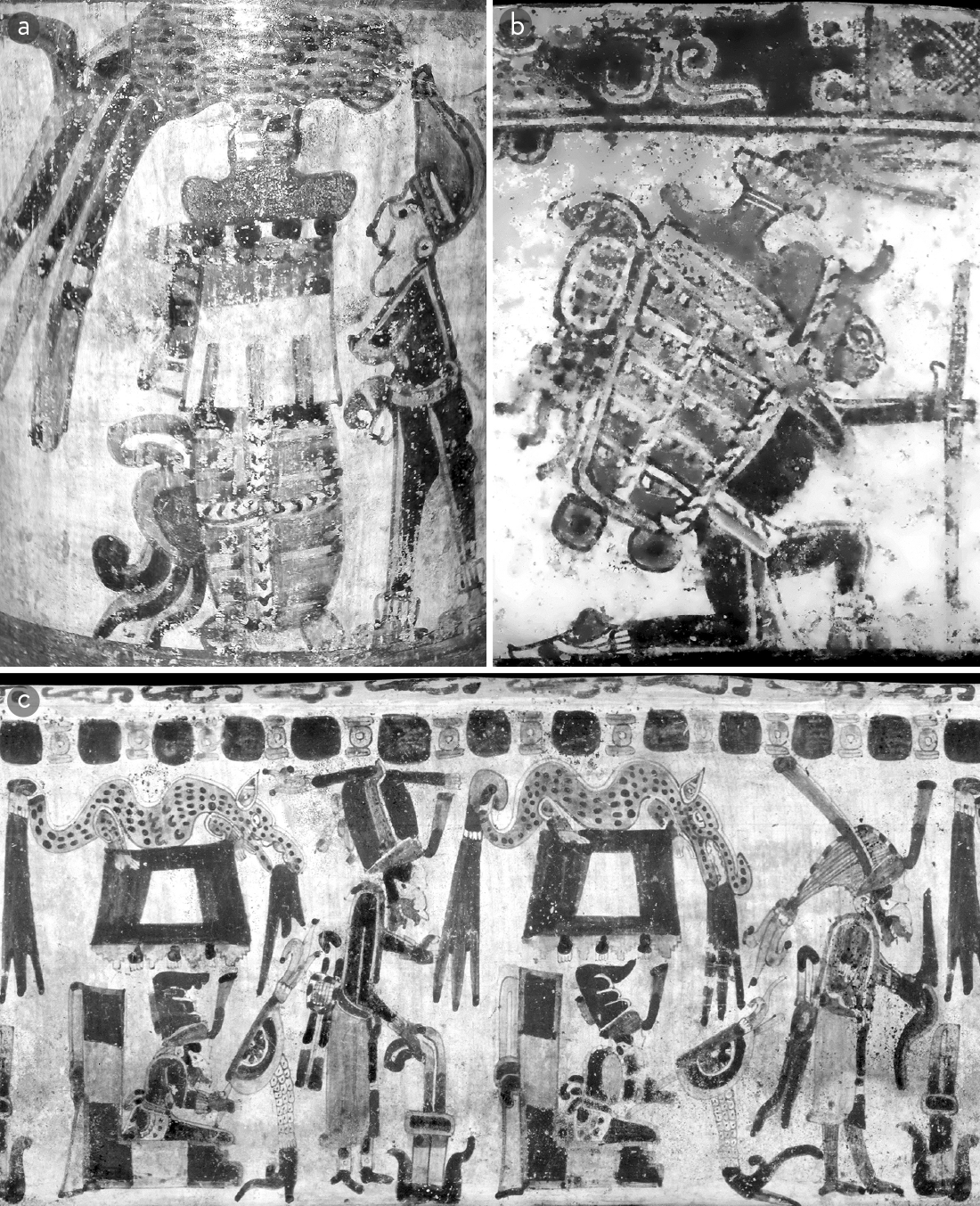
Figure 6. Comparison of details on Ulúa Polychrome vases: a) “stack” showing animal crest, effigy house, and tied bundle wrapping an incense burning vessel, Museo de Antropología e Historia (ab 11), San Pedro Sula, Honduras (modified from photo by Russell N. Sheptak); b) person carrying tied bundle/vessel with animal crest, Hudson Museum (HM 516), Maine, United States (Kerr n.d.: K6992); c) animal crest on house/altar (Kerr [n.d.: K4577], illustration by Jeanne Lopiparo). Figura 6. Comparación de los detalles de los vasos Ulúa Policromo: a) “pila” con escudo de animal, casa efigie y fardo atado que envuelve un recipiente para quemar incienso, Museo de Antropología e Historia (ab 11), San Pedro Sula, Honduras (modificada desde una fotografía de Russell N. Sheptak); b) persona que lleva fardo/recipiente atado con escudo de animal, Hudson Museum (HM 516), Maine, Estados Unidos (Kerr s.f.: K6992); c) escudo de animal sobre casa/altar (Kerr [s.f.: K4577], ilustración de Jeanne Lopiparo).
This could be viewed as an iconological and iconographic analysis taking place, as Davis (2004) asserts is normal, at the same time. In actuality, my identifications rest on a semiotic analysis of indexicality, connecting parts of the image to things they point to in the lived world of the polychrome makers and users. I can re-cognize this stack of visual elements as a kind of object archaeologists encounter: incense burning vessels with lids supporting three-dimensional figurative sculptures. The recognition of the bundle painted on the pot as depicting a ritual object is simultaneously descriptive (a recognition of form and motif) and interpretive (the identification of the motifs as indexing ritual bundles actually present in archaeological sites). The person on the right of this polychrome scene is facing a ritual bundle, composed of a vessel topped by an animal figure (fig. 6a). Understanding what this image means requires us to explore what animals do in Ulúa visual culture in relation to the actions of humans.
Nonhuman animals as actors
In museum collections and publications about Ulúa Polychromes, human or anthropomorphic subjects are the most common focus. Yet Ulúa visual culture is populated by a universe of figures in which nonhuman animals are common. Animals appear as independent subjects of figurines, larger ceramic sculptures, and stone sculpture. On Ulúa Polychrome vessels from the 7th and 8th century ad, zoomorphic characters are as common as anthropomorphic figures, and can occupy the majority of the visual field (fig. 7). We could equate them with zoomorphic figures in Classic Maya art, identified through textual analyses as the alter-egos of supernatural beings or the souls of especially powerful humans (Grube & Nahm 1994; Velásquez 2020). Yet equating something like the flying creature on this Ulúa Polychrome vase, with its segmented body, red head protruding from the vessel wall, and red legs, with a Classic Maya motif ignores the specific Honduran cultural and spiritual history provided by the performative context in which this vessel participated.
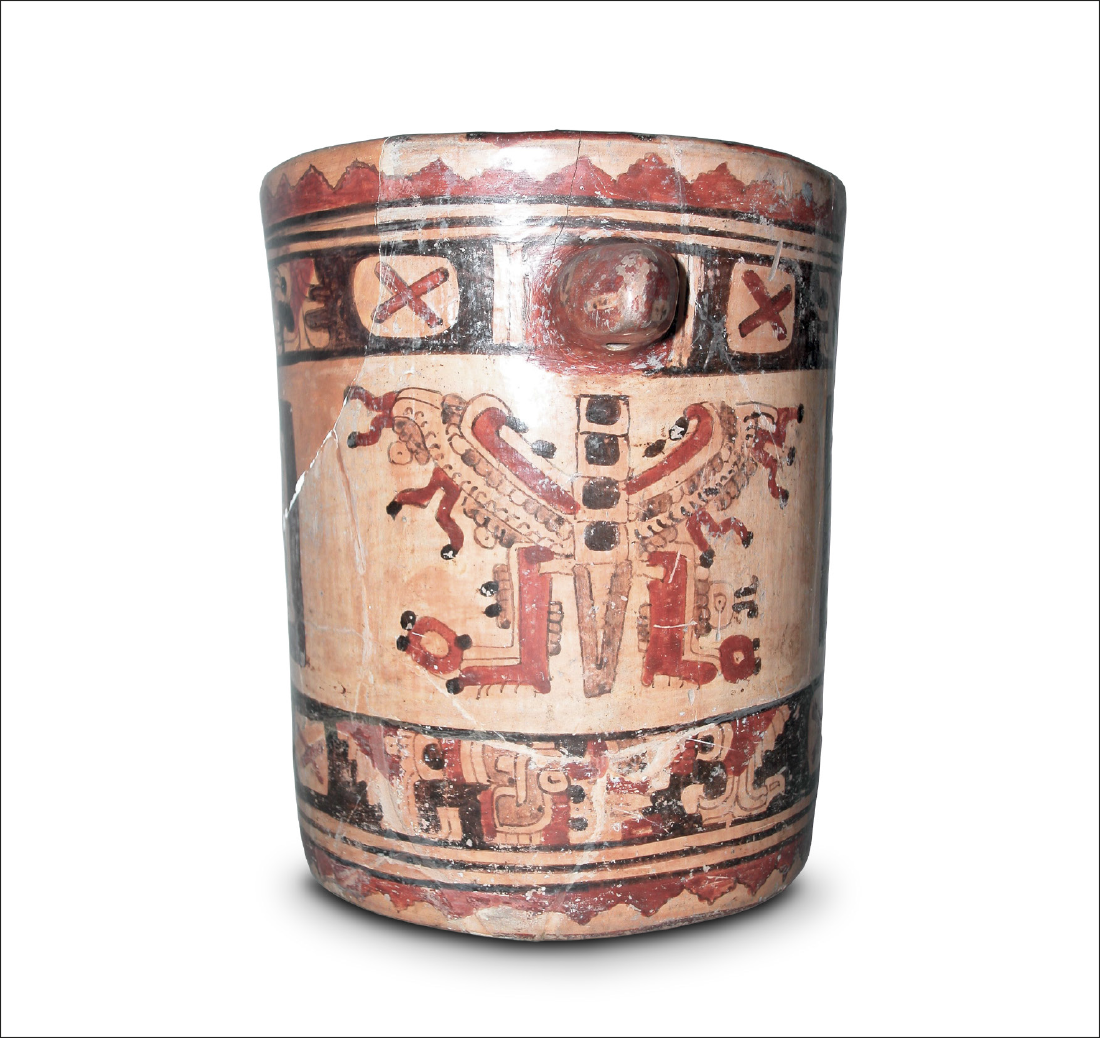
Figure 7. Ulúa Polychrome vase, Paloma subclass, showing frontal view of a hybrid flying creature, Santa Rita site, Museo de Antropología e Historia (AB2), San Pedro Sula, Honduras (photo by Russell N. Sheptak). Figura 7. Vaso Ulúa Policromo, subclase Paloma que muestra la vista frontal de una criatura voladora híbrida, sitio Santa Rita, Museo de Antropología e Historia (AB2), San Pedro Sula, Honduras (fotografía de Russell N. Sheptak).
There are clear differences in the presence of animals in Ulúa and Maya visuality. Erik Velásquez (2020: 16) notes that in Maya visual culture, groups of zoomorphic figures appear together, “suspended in the air, without any representation of their surroundings”. Ulúa Polychrome vessels show individual zoomorphic actors in the same way they show humans, standing on a ground line, each framed with motifs that reference spatial locations, like the stepped terraces above and below the avian creature (fig. 7), or at the base of vessels depicting a monkey character (fig. 8).
Unlike the Classic Maya compositions in which multiple zoomorphic entities appear, each Ulúa Polychrome vessel presents one animal as a central zoomorphic actor. Like those on Classic Maya vessels, Ulúa zoomorphs display features that go beyond the animal, often wearing jewelry. Yet their actions and the symbolic features guiding their interpretation are quite different. Classic Maya zoomorphs are associated with bloody and threatening imagery of “skeletons, bats, snakes, jaguars, and unnatural beings” (Velásquez 2020: 18). The Honduran bestiary is dominated by monkeys and a variety of birds, and includes less common species such as iguanas, armadillos, crabs, frogs, peccaries and deer (Joyce 2017: 50-60, 129-145). Ulúa monkey figures dance; birds are shown with fish they have just captured. Classic Maya zoomorphs may combine aspects of multiple species “especially eagles, hawks, or centipedes […] and owls” (Velásquez 2020: 18). Only one Ulúa zoomorph appears to be a composite, with varying characteristics of insect, bat, and bird (fig. 7) but none of the threatening features of Classic Maya analogues, such as the human skeletal elements seen in Classic Maya bat imagery.
Zoomorphic subjects occur in different proportions in visual culture at specific Honduran settlements (Hendon et al. 2014; Joyce 2017). Water birds are especially common in sites near Lake Yojoa, peccaries in the Comayagua valley, and monkeys (fig. 8) are abundant at the site of Travesía. While these are not absolute exclusions, they suggest differences in the cultural and historical importance of diverse animals to distinct communities. Rather than index the souls of powerful and even threatening individuals, the Ulúa animals populate a landscape in which anthropomorphic animals established models of ritual action in mythological time, models that human actors emulate (Hendon et al. 2014: 118-127; Joyce 2017: 289-293).

Figure 8. Ulúa Polychrome vase, Bombero subclass, showing frontal view anthropomorphized monkey, Travesía site, Museo de Antropología e Historia (sps 109), San Pedro Sula, Honduras (photo by Russell N. Sheptak). Figura 8. Vaso Ulúa Policromo, subclase Bombero, que muestra la vista frontal de mono antropomor-fizado, sitio Travesía, Museo de Antropología e Historia (sps 109), San Pedro Sula, Honduras (fotografía de Russell N. Sheptak).
Imagery of authority
Instead of seeking the references for meaning of Ulúa polychromes in stories recorded by speakers of entirely different languages, living in settlements that were larger and more hierarchical than those where Ulúa Polychromes were made and used, my first resource for their cultural and spiritual history is the performative context in which they participated, documented through archaeological research. This extends even to the works with the greatest resemblance to those of contemporary Classic Maya sites, cylinders on which multi-figure scenes involving actions by anthropomorphic figures unfold as the vessel is turned. Painted in the 8th century ad, vessels with a single field occupied by a continuous multi-figure composition are an innovation. They are first hinted at in that century vessels where a single human figure faces a ritual bundle (fig. 2). In earlier vessels (fig. 9) human figures face and reach towards ritual regalia, such as masks (Joyce 2017: 25-26, 288-289).

Figure 9. Seated figure on Ulúa Polychrome vase, Chac subclass, reaches toward mask floating to the right, Dédalos site, Museo de Antropología e Historia (hf), San Pedro Sula, Honduras (photo by Russell N. Sheptak). Figura 9. Figura sentada sobre vaso Ulúa Policromo, subclase Chac, que se extiende hacia la máscara que flota a la derecha, yacimiento de Dédalos, Museo de Antropología e Historia (hf), San Pedro Sula, Honduras (fotografía de Russell N. Sheptak).
By the end of the 8th century ad, compositions showing multiple anthropomorphic participants performing in rituals became standard subjects of cylindrical vases, even as the more common dishes and bowls in Ulúa style continued to focus on zoomorphic subjects. The new format may have been inspired by knowledge of Classic Maya vases, some of which were imported to sites like Travesía in that time (Joyce 2017: 222-225). Yet we need to account for the work this format accomplished, what effects it had, as called for by Peirce’s (1878: 286) concept of the “pragmatic maxim”.
On Ulúa Polychromes vases, the single scene, multi-figure format did not have the effect of making a named noble a focus. Ulúa Polychromes use this format to represent shared actions involving multiple participants. On a cylinder likely from Tenampua site, a late 8th to 9th century ad hilltop fortress in the Comayagua valley, one side presents a pair of figures facing each other over a cylindrical vessel with smoke billowing up (fig. 10a). On this vessel, the human figures hold rattles in one hand and an object ending in a serpent head in the other. Serpent heads and animal paws serve as handles for incense burning vessels recovered in the same deposit (fig. 11). The cultural history archaeology provides allows me to read the scene on the cylinder as one of ritual practice, burning of incense in hand-held vessels flanking another censer of a form, recovered from the same cache, which was provided with a lid to smother the fire inside when the ritual was finished (fig. 12).
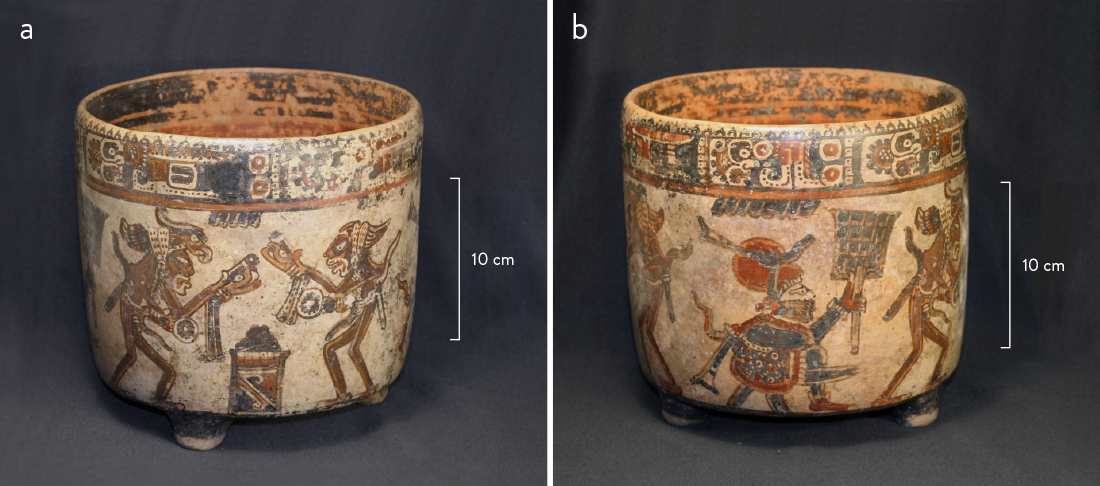
Figure 10. Ulúa Polychrome vase, Cefiro subclass, with multi-figure scene, Tenampua site: a) two standing figures flank a vessel of burning incense; b) showing a seated figure holding a fan gazes toward the incense burning ceremony, National Museum of the American Indian (nmai), Smithsonian Institution (244275), Washington dc, United States (photos by Russell N. Sheptak). Figura 10. Vaso Ulúa Policromo, subclase Cefiro, con escena de varias figuras, sitio Tenampua: a) dos figuras de pie flanquean un recipiente con incienso encendido; b) muestra una figura sentada que sostiene un abanico que mira hacia la ceremonia de quema de incienso, National Museum of the American Indian (nmai), Smithsonian Institution (244275), Washington dc, Estados Unidos (fotografías de Russell N. Sheptak).
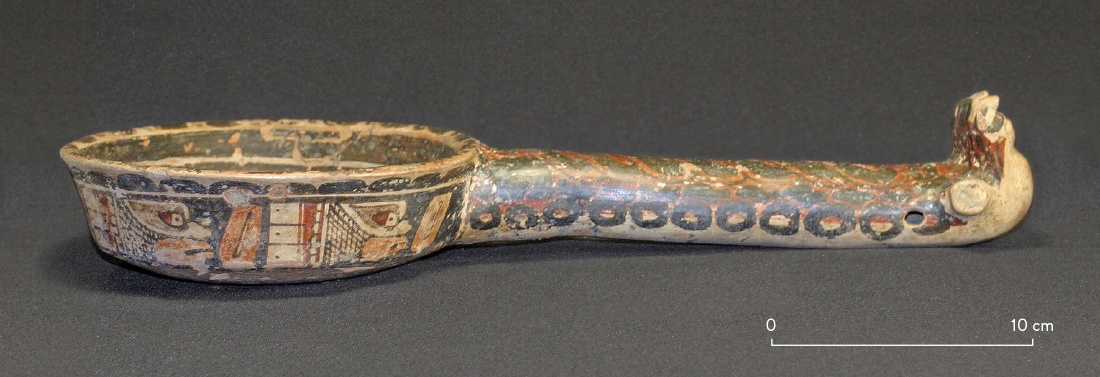
Figure 11. Ulúa Polychrome ladle censer, Tenampua class, Tenampua site, National Museum of the American Indian (nmai), Smithsonian Institution (244302), Washington dc, United States (photo by Russell N. Sheptak). Figura 11. Incensario de cucharón Ulúa Policromo, clase Tenampua, sitio Tenampua, National Museum of the American Indian (nmai), Smithsonian Institution (244302), Washington dc, Estados Unidos (fotografía de Russell N. Sheptak).
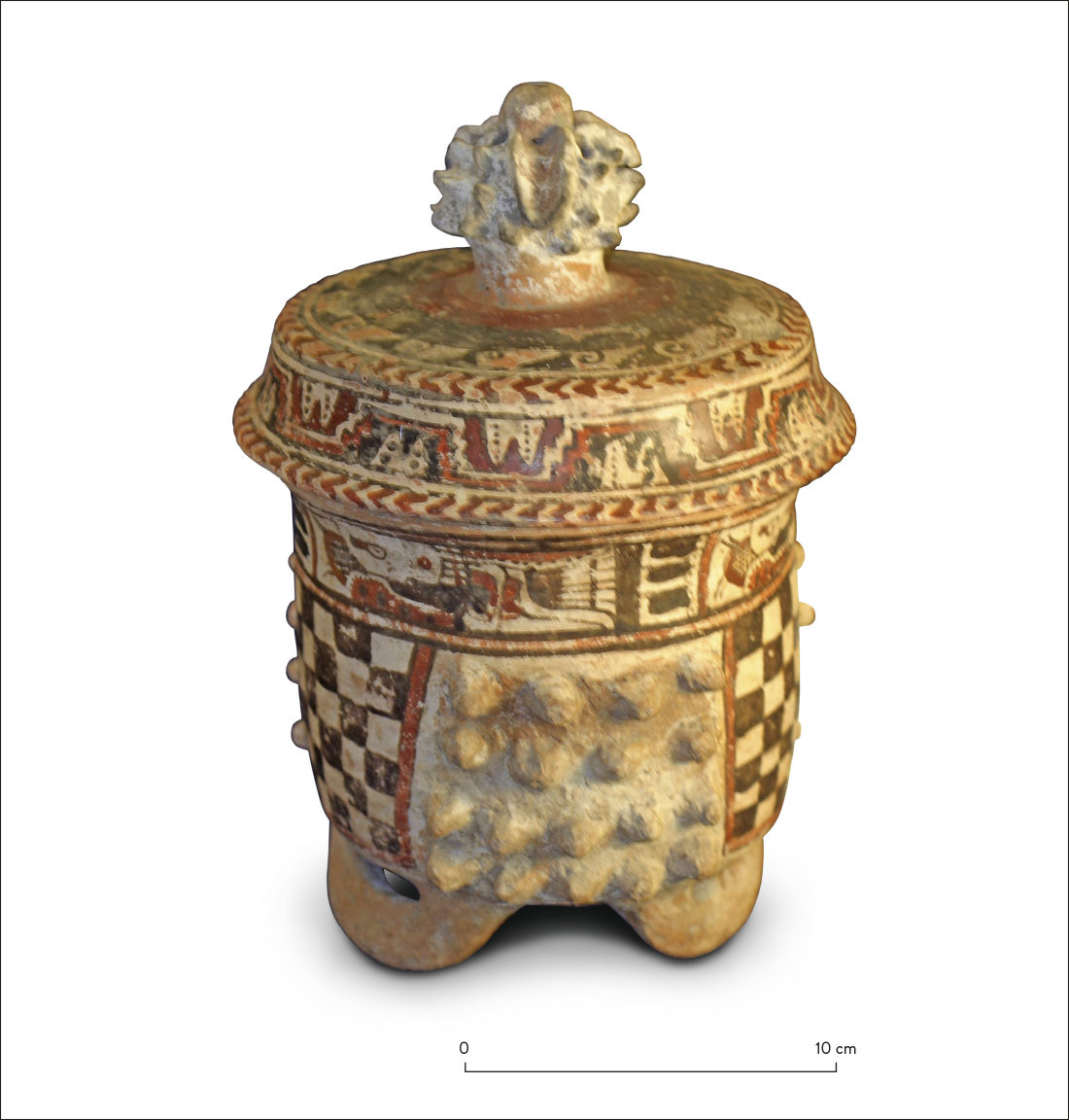
Figure 12. Vase with lid, Zarza subclass, Tenampua site, National Museum of the American Indian (nmai), Smithsonian Institution (243265), Washington dc, United States (photo by Russell N. Sheptak). Figura 12. Vaso con tapa, subclase Zarza, yacimiento de Tenampua. National Museum of the American Indian (nmai), Smithsonian Institution (243265), Washington dc, Estados Unidos (fotografía de Russell N. Sheptak).
Like contemporary Classic Maya polychrome cylinders, the continuous pictorial scene on the cylindrical vase from Tenampua allows more than a single view. Turning the cylinder, we are presented with a second view, showing a figure seated on a bench, holding a rectangular fan in one hand (fig. 10b). This figure gazes toward the incense burning scene, which is always at least partly included in view as the vessel is turned.
The temptation is to follow the conventions of Classic Maya iconography and describe this as the image of a commanding figure, an authority, a chief or ruler. That, again, would be to ignore the local cultural context, the local spiritual history. There is no evidence of a hierarchical class of rulers in Ulúa sites. Even the visuality employed here, which ensures this figure can never dominate the visual field alone, emphasizes the relationship of the seated and standing figures. The subject of Ulúa Polychromes is ritual performance, not politics.
In the absence of a class of rulers, who is this seated figure, and others like it who appear at the edge of rituals depicted on Ulúa Polychrome vessels? They are witnesses of ritual events. They may have had authority during them, as specialists, knowledge keepers. In Lenca rituals practiced today, called compostura, experts who know how to call forth spirits of earth and the plants, animals, and minerals on which humans depend have similar centrality, but only during the ritual events (Travieso 2019).
Human figures on Ulúa Polychromes are not named historical persons. In multi-figure scenes, costumes and regalia are repeated without distinctions that would allow us to identify a permanent hierarchical position. An aspect of costume may be more detailed on one figure than another in a multi-figure scene. For example, the detailed rendering of a bird shown tied onto the head of the left-hand practitioner in the incense burning scene (fig. 10a) allows us to recognize the same element, reduced to a bird wing and possible beak, in the headdress of the right-hand figure. Headdresses like these are possibly emblematic of local group identities, as they are in Ulúa ceramic figurines (Lopiparo 2007).
The only component of Ulúa visual culture that seems to feature unique characters are the larger ceramic sculptures. Here, a pregnant woman carrying a bundle on her back, a man dressed in a feathered costume, and another man wearing a simple turban, brandishing an axe, are each unique images with purely local significance (Lopiparo & Joyce 2022). Apparently made for single events in specific sites, these sculptures may be testimony to specific personages who were important in local communities. Yet they are not recorded by name or title using anything like the Classic Maya writing system.
DISCUSSION
This paper argues that context for visual culture can be provided as much by a rich understanding of material conditions as from documents that might have recorded traditions, histories, and beliefs of the makers of ancient artworks. Ulúa visual culture, embodied in five media featuring mixtures of anthropomorphic and zoomorphic imagery, developed over five centuries in the context of ritual performances that reproduced community ties and identities. These five media –small scale mold-made fired clay figurines, larger fired clay sculptures made to mount over vessels filled with burning incense, polychrome painted ceramic vessels, carved marble vases in shapes that echo those of polychrome ceramics, and architectural sculpture– show distinct emphases in themes, motifs, and styles that suggest multiple audiences and discourses were involved in their circulation. Yet they also exhibit clear connections to each other in motifs and themes, and were used together in events, the residues of which archaeologists recover.
Semiotic theory, informed by a critical approach to iconographic analysis, helps establish how we can recognize assemblages of line and color as referring to things in the world, through iconicity and indexicality, in the absence of touchstones for understanding conventionalization of symbolic meaning which are provided by texts in other cases. The critique of iconographic method by Davis (2004) shows that iconographic analysis is not a step-by-step process from neutral description to interpretation. Description always already relies on interpretive framing. Meaning is constantly produced within a specific cultural history.
In this study, I showed how at the moment of greatest entanglement of Ulúa people with their Maya neighbors, between ad 700 to 850, features of Ulúa Polychrome vessels that have previously been viewed through the lens of Classic Maya culture can be unders-tood as part of a specific Honduran Lenca visuality with its own history of cultural and spiritual significance. I demonstrate that the divergence of Ulúa Polychromes from Maya polychrome models is rooted in distinct histories of development, production, circulation, and meaning-making of these artworks. One part of this historical context was social and ceremonial engagement with people in the Maya Lowlands. Yet even when the visual similarities seem closest, the meaning –the spiritual significance– of Ulúa visual culture is rooted in the specificity of a network of less hierarchical social groups integrated through shared ritual practice, rather than through political domination and administration.
Casanova, A., M. Micheli, M. Ricci, M. Toledo, F. Bellatreccia, S. Lo Mastro & A. Sodo 2016. Raman, sem–eds and xrpd Investigations on Pre-Columbian Central America “estucado” Pottery. Spectrochimica Acta Part A: Molecular and Biomolecular Spectroscopy 156: 47-53.
Costenla, A. 1991. Las lenguas del Área Intermedia: introducción a su estudio areal. San José: Editorial de la Universidad de Costa Rica.
Davis, W. 2004. Visuality and Pictoriality. res, Anthropology and Aesthetics 46: 9-31.
de la Fuente, G., F. Marte, N. Mastrangelo, M. Martínez, G. Rozas, S. Vera, C. Nazar & M. Tascón 2021. Raman and ft–ir Spectroscopy of Prefiring Paintings and Slips in Pre-Hispanic South American Pottery. The Case of Diaguita Inca Pottery: An Initial Glazing-Painting Process? (Tinogasta, Catamarca, Argentina). Archaeological and Anthropological Sciences 13 (10): 1-8.
Dikovitskaya, M. 2005. Visual Culture: The Study of the Visual After the Cultural Turn. Cambridge: The mit Press.


